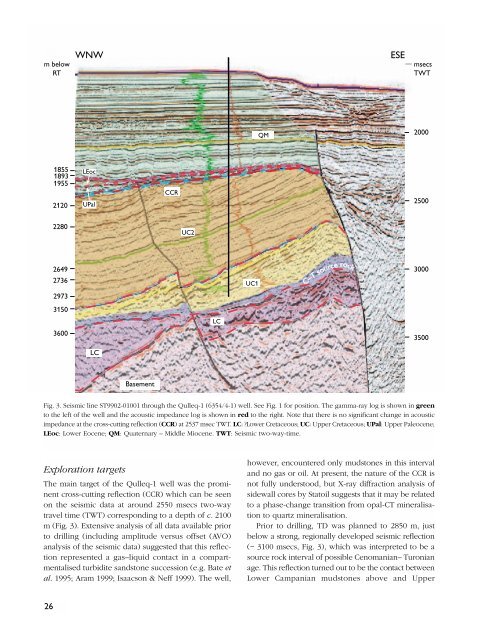The Nalunaq gold prospect, South Greenland - Geus
The Nalunaq gold prospect, South Greenland - Geus
The Nalunaq gold prospect, South Greenland - Geus
You also want an ePaper? Increase the reach of your titles
YUMPU automatically turns print PDFs into web optimized ePapers that Google loves.
m below<br />
RT<br />
WNW<br />
ESE<br />
msecs<br />
TWT<br />
QM<br />
2000<br />
1855<br />
1893<br />
1955<br />
2120<br />
LEoc<br />
UPal<br />
CCR<br />
2500<br />
2280<br />
UC2<br />
2649<br />
2736<br />
UC1<br />
C–T<br />
source<br />
rock<br />
3000<br />
2973<br />
3150<br />
LC<br />
3600<br />
3500<br />
LC<br />
Basement<br />
Fig. 3. Seismic line ST9902-01001 through the Qulleq-1 (6354/4-1) well. See Fig. 1 for position. <strong>The</strong> gamma-ray log is shown in green<br />
to the left of the well and the acoustic impedance log is shown in red to the right. Note that there is no significant change in acoustic<br />
impedance at the cross-cutting reflection (CCR) at 2537 msec TWT. LC: ?Lower Cretaceous; UC: Upper Cretaceous; UPal: Upper Paleocene;<br />
LEoc: Lower Eocene; QM: Quaternary – Middle Miocene. TWT: Seismic two-way-time.<br />
Exploration targets<br />
<strong>The</strong> main target of the Qulleq-1 well was the prominent<br />
cross-cutting reflection (CCR) which can be seen<br />
on the seismic data at around 2550 msecs two-way<br />
travel time (TWT) corresponding to a depth of c. 2100<br />
m (Fig. 3). Extensive analysis of all data available prior<br />
to drilling (including amplitude versus offset (AVO)<br />
analysis of the seismic data) suggested that this reflection<br />
represented a gas–liquid contact in a compartmentalised<br />
turbidite sandstone succession (e.g. Bate et<br />
al. 1995; Aram 1999; Isaacson & Neff 1999). <strong>The</strong> well,<br />
however, encountered only mudstones in this interval<br />
and no gas or oil. At present, the nature of the CCR is<br />
not fully understood, but X-ray diffraction analysis of<br />
sidewall cores by Statoil suggests that it may be related<br />
to a phase-change transition from opal-CT mineralisation<br />
to quartz mineralisation.<br />
Prior to drilling, TD was planned to 2850 m, just<br />
below a strong, regionally developed seismic reflection<br />
(~ 3100 msecs, Fig. 3), which was interpreted to be a<br />
source rock interval of possible Cenomanian– Turonian<br />
age. This reflection turned out to be the contact between<br />
Lower Campanian mudstones above and Upper<br />
26

















